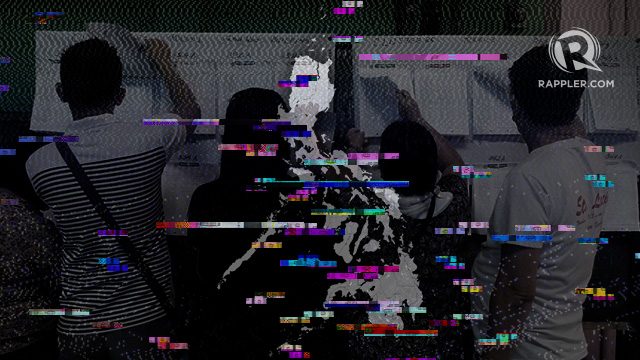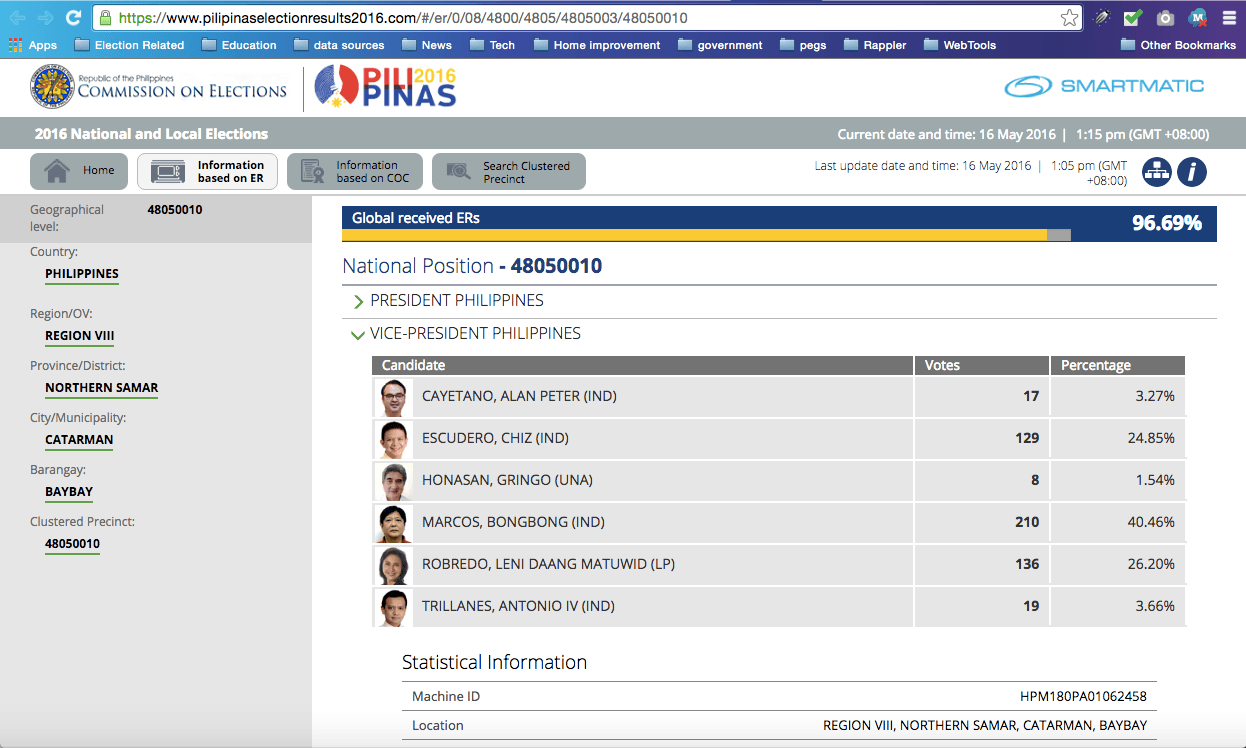SUMMARY
This is AI generated summarization, which may have errors. For context, always refer to the full article.

MANILA, Philippines – At 10:58 pm on Sunday, May 15, user @OrgeMaizzy tagged Rappler on Twitter, asking for an explanation why the votes for vice presidential candidate Ferdinand Marcos Jr dropped to 13,803,444 at 7:55:34 pm from 13,803,654 the previous hour (6:55:50pm).
@PHVote pls explain this?
— maizzymo (@OrgeMaizzy) May 15, 2016
6:55:50pm bbm got13,803,654
After 1hour
7:55:34pm bbm got only13,803,444
What happened?? pic.twitter.com/WhG4pWMdUY
Our IT and research teams double-checked this report against the result files we receive via the Comelec mirror server. We noted that the reason for the drop was because the file released to observer workstations by the transparency and mirror servers at 7:45 pm on Sunday night did not have the results for clustered precinct number 48050010.
Clustered precinct number 48050010, which is situated at the Baybay Elementary School in Barangay Baybay, Catarman, Northern Samar, was last reflected in the file transmitted at 6:45 pm.
When this precinct dropped from subsequent versions of the results file, Marcos was not the only one whose votes was affected in the unofficial partial results.
His closest rival to the vice presidency, Leni Robredo, was also also affected, as she was supposed to receive 136 votes from the same precinct. From 14,022,878 at 6:55 pm, her votes went down in the unofficial partial tally to 14,022,742 an hour later.
This is not the first time we noticed that there were precinct result files present in previous result files but were dropped in later versions of the files.
All in all Rappler has tracked 18 dropped precincts so far. Rappler first alerted Comelec representatives managing the transparency and mirror servers about this issue on Wednesday, May 11, two days after election day.
Impact on VP race
Accounting for a total of 7,348 actual voters, votes from these affected precincts could still be material to the tight vice presidential race, given very narrow, potentially only 5-digit, gap between the two top contenders.
But all is not lost.
The transparency server is only one of the 3 servers to which the vote counting machines transmit digital election returns (ERs) during the elections. (Read: How does the PH automated election system work?)
The two other recipients of the digital ERs are the municipal and canvassing servers and the Comelec’s server, which displays results received on www.pilipinaselectionresults2016.com.
On checking we found a copy of the results for clustered precinct number 48050010 on www.pilipinaselectionresults2016.com. See the screenshot below:
Also available on www.pilipinaselectionresults2016.com were results for 4 more precincts that got dropped.
Previous versions of results files
By checking previous versions of the result files, Rappler was also able to find the results for the remaining precincts that got dropped.
The spreadsheet below lists all the precincts that were previously reflected in the unofficial election results but got dropped in later results. It includes last file version in which results for those precincts were shown.
Scroll to the right to view the votes for each of the vice-presidential candidates from the dropped precincts. (Note: precinct marked blue appears to have transmitted test results. Colors indicate whether Robredo or Marcos won in the precinct.
Based on previous versions of the results files, Marcos was supposed to receive a total of 2,947 from the 18 precincts that the transparency server results file dropped. Robredo, on the other hand, was supposed to receive 1,971 votes.
This was possible to check because accredited observers are not getting the digital versions of the encrypted election returns which are transmitted individually by over 92,000 vote counting machines on election day. With each update in the unofficial canvass they actually get a delimiter separated value file, which compiles all results available so far in the transparency server database.
New precincts received are merely appended as additional rows in this file, which gets bigger as the unofficial canvass progressed.
The hash of this results file became the subject of a controversy earlier. The camp of Marcos Jr claimed that, after a change in the hash of this file was detected at 7:30pm on May 9, votes for Marcos began to “erode at a rather distinctive pattern” and Robredo’s votes started to surge.
The Comelec denied the cheating allegation and clarified that the hash was changed after a “cosmetic change” was made in the results files. The character Ñ was initially shown as question marks in the files and this caused a mismatch in the names of the candidates listed in the files with a previous list of candidates released by the Comelec.
In a demo to watchdog groups, the media, and political parties, Smartmatic showed that the change in the hash attributed to the Ñ correction was replicable.
It was Rappler’s IT team that notified the Comelec about this error. Rappler’s own analysis has debunked the Marcos camp’s claim of a cheating pattern.
All candidates affected
It also must be stressed that the dropped precincts did not affect the votes of Marcos and Robredo only.
Other VP candidates who received votes from the dropped precincts were also affected. Escudero’s total votes went down by 923 votes, Cayetano’s by 629 votes, Trillanes’ by 166, and Honasan’s by 139 votes.
All candidates, from national to local, with votes in said precincts were affected when the precincts got dropped in later versions of the files. This further indicated that what happened was a system glitch, not targeted to any candidate.
Not dagdag-bawas
Comelec Chairman Andres Bautista said they are looking into the matter, but gave assurances that “no cheating or dagdag-bawas (padding-shaving of votes) that is happening.”
He added: “What is possible is that, [when] two data transmissions [are] made, what happens is that data is quarantined. It is first set aside, so that we can verify which is the right transmission. And this is what happened, for example, in Davao del Sur.”
The basis for the proclamation of winners for the national and local elections is the official results, which are initially transmitted to the municipal and city board of canvassers, then to the provincial and finally to the Comelec sitting as the National Board of Canvassers in the case of the senatorial and party-list races.
Meanwhile, official results for the president and vice president, duly certified by the board of canvassers of each province or city, are transmitted to Congress in joint public session. During this exercise, the authenticity and due execution of each election return will be scrutinized before they are tabulated. – with Wayne Manuel and Paterno Esmaquel II/Rappler.com
Add a comment
How does this make you feel?

There are no comments yet. Add your comment to start the conversation.